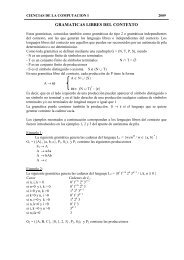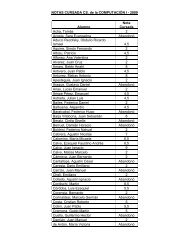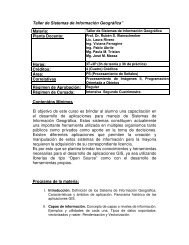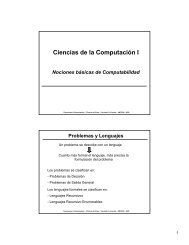Propagacion de errores. Practica Nro1
Propagacion de errores. Practica Nro1
Propagacion de errores. Practica Nro1
You also want an ePaper? Increase the reach of your titles
YUMPU automatically turns print PDFs into web optimized ePapers that Google loves.
Ahora, <strong>de</strong>spejando v0<br />
v<br />
0<br />
=<br />
g<br />
xf−x0 2 cos θ − y + y + tgθ( x −x<br />
)<br />
f 0 f 0<br />
(6)<br />
Ahora bien, para calcular el error <strong>de</strong> v0, se <strong>de</strong>bería aplicar la ecuación (1); es <strong>de</strong>cir,<br />
hacer la propagación <strong>de</strong> <strong>errores</strong> <strong>de</strong> todas las variables que tienen error. En este caso<br />
vamos a consi<strong>de</strong>rar que las variables que aportan al error son xf, y0 y θ. Por simplicidad<br />
vamos a asumir x0 e yf iguales a cero, <strong>de</strong> modo que<br />
v<br />
0<br />
=<br />
Entonces:<br />
g x f 1<br />
2 cosθ<br />
y + x ⋅ tgθ<br />
0<br />
0 0 0<br />
0<br />
∂xf f<br />
∂y0 0<br />
∂<br />
f<br />
(7)<br />
∂v ∂v ∂v<br />
Δv ≤ . Δ x + . Δ y + . Δθ<br />
θ<br />
Vayamos por parte, primero calculemos las <strong>de</strong>rivadas parciales.<br />
∂v<br />
g 1 x 1<br />
=−<br />
∂ +<br />
0<br />
f<br />
y0 2cosθy tgθx 3/2<br />
2<br />
( 0<br />
f )<br />
(9)<br />
(8)<br />
∂v0<br />
g 1 1 1 g 1 xtgθ<br />
= −<br />
∂ x f 2cosθ y + tg x 2 2cosθ<br />
y + tg x<br />
f<br />
1/2 3/2<br />
( 0 θ f ) ( 0 θ f )<br />
∂v<br />
g tgθ x 1 g 1 x x<br />
= −<br />
( y0 tgθxf ) ( y0 tgθxf )<br />
(10)<br />
0<br />
f f<br />
f<br />
1/2 3/2 2<br />
∂ θ 2 cosθ + 2 2 cosθ + cos θ (11)<br />
La primera <strong>de</strong>rivada es relativamente simple ya que y0 aparece sólo una vez en la raíz en<br />
el <strong>de</strong>nominador y se pue<strong>de</strong> buscar en tablas.<br />
En la <strong>de</strong>rivada con respecto a xf, éste aparece tanto en el numerador como en el<br />
<strong>de</strong>nominador, y por eso al <strong>de</strong>rivar aparecen dos términos.<br />
Finalmente la <strong>de</strong>rivada respecto a θ es más compleja porque aparecen dos funciones<br />
trigonométricas. La estrategia que se podría usar es suponer a la función v0 como<br />
producto <strong>de</strong> dos funciones A(θ) y B(θ), <strong>de</strong> manera que v0= A(θ).B(θ) y siendo<br />
g x f g<br />
A( θ ) = = xfsecθ(12)<br />
2cosθ 2<br />
1<br />
B(<br />
θ ) =<br />
(13)<br />
y + tgθx 0<br />
f<br />
De esta manera se pue<strong>de</strong> aplicar la <strong>de</strong>rivación en un producto <strong>de</strong> manera que<br />
∂v0<br />
= A'B+ AB'<br />
∂θ<br />
(14)


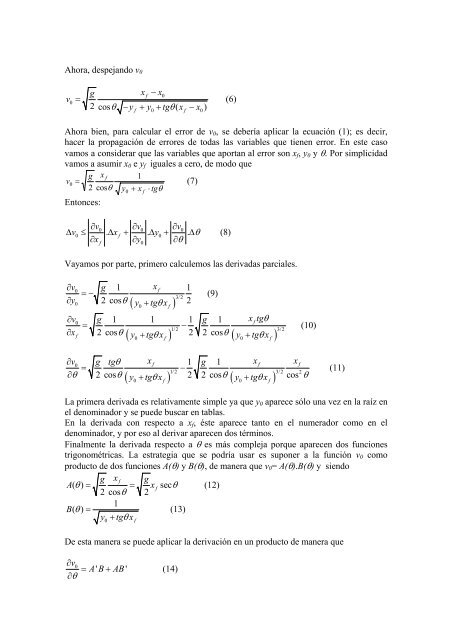
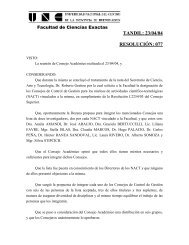
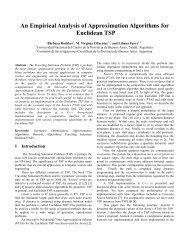
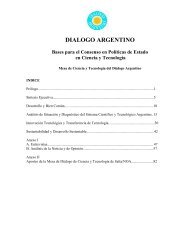


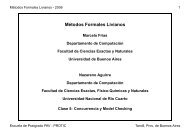
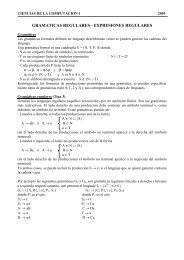

![Clase 13 [pdf]](https://img.yumpu.com/19616969/1/190x245/clase-13-pdf.jpg?quality=85)

